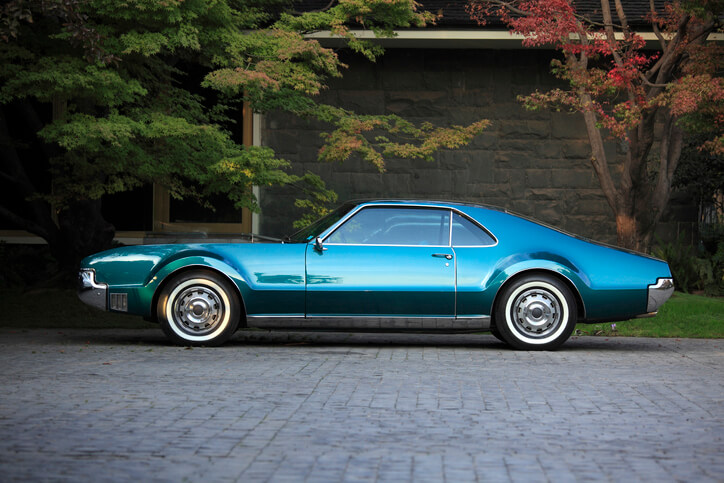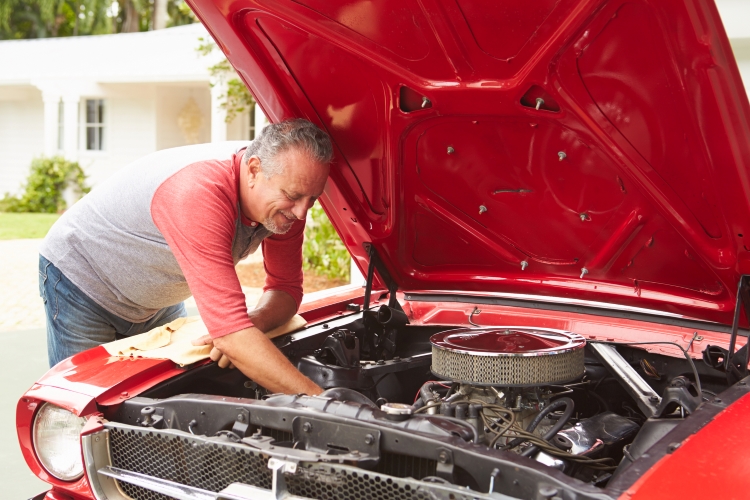Sure, you prep your classic car for winter, but don’t forget to do the same for spring and summer driving. This is true even for cars you keep garaged during the winter. Cold weather brings a myriad of issues that can damage your car and steer you into unsafe conditions.
Here’s how to jump-start your classic car prep for warm weather driving:
Head-to-Toe Winter Recovery Inspection
Carefully examine your car’s exterior, under the hood and inside the cabin. Jot down any safety or appearance concerns.
Exterior
- Note any nicks or chipped paint.
- Check that windshield wipers are sturdy and whole and that they aren’t peeling and need to be replaced.
- Make sure headlamps or rear lamps aren’t dull.
- Confirm that the windshield is free of cracks or chips.
- Make sure the side mirrors are clear and easy to adjust.
Use a tire gauge and measure the air pressure. You will likely need to adjust it as extreme temperatures impact tire pressure. You can find the correct tire pressure in the owner’s manual or on the inside edge of the driver’s side door. If you don’t see it there, check inside the trunk lid, near the fuel door and inside the glove box.
Look Under the Hood
Lift the hood and inspect your engine. Squirrels, mice and small animals seek shelter near car engines during cold weather. Check for holes, bite marks and other damage on belts, hoses, cords and other critical components. Also remove any shells or other debris.
Then check your fluids. You will want the oil and perhaps other fluids changed, but it’s important to make sure that driving your car — even a short distance — is safe. Don’t forget to have your battery checked, too.
Examine the Inside
Once inside the car, make sure there is no water leakage, like from a cracked windshield. Start the car (provided the fluids are adequate). Sniff the air. Does the car cabin have an odd odor? It might be time to change the cabin air filter. Switch on the air conditioner. Does it blow and cool well?
Take It for a Spin
If your car is safe to drive, take it for a short spin and listen for any odd sounds such as grinding, pinging or squealing. Those noises may indicate mechanical issues.
Once you complete your personal inspection, take your list of concerns and go to a trusted auto technician or car care center. Don’t be surprised if the technician has other recommendations. Winter is tough on cars.

Clean and Wax Tips
When the car is mechanically ready for spring, thoroughly wash and wax it.
One caveat: If you have any dings or scratches on the exterior paint, consult with a body shop first. You don’t want to worsen the damage. Ask for advice on what steps to take to best repair the paint, chrome or other exterior coverings.
Most classic car owners know that washing such a car is an art. While avoiding the automated car washes, classic car owners may wash their cars more frequently because bugs, road grime and other contaminants quickly damage the paint. Some classic car owners go so far as to only use bottled water when rinsing their cars.
You don’t need go that far, but you will want to take special care with your classic car:
- Only use sheepskin or chenille cloths or gloves to prevent marks.
- Start at the top of the car and work down, so dirt doesn’t drip on clean surfaces.
- Thoroughly rinse the car with flowing water (again, no need to use bottled, but make sure you don’t skimp on the rinse).
- Dry the car — top to bottom — thoroughly with clean and dry soft leather chamois or microfiber cloths.
- Do not leave any water on the car, especially not in the hard-to-reach areas, to prevent rust.

Drive Safely
Even after a car is mechanically safe to drive, classic car owners should consider other safety steps. Some classic car purists don’t install or replace seat belts or shoulder harnesses. Enthusiasts often post on auto message boards that their careful driving keeps them safe.
Yet the Centers for Disease Control (CDC) reports that seat belts are the most effective way to prevent injury and death in car accidents. Seat belts are so important that Gordon McCall, CEO of McCall Events and well-known restorer, collector, driver and racer of classic cars, told AARP that some car show judges consider passenger restraints vital and “look the other way” when judging and scoring classic cars.
Consider installing them. Seat belts will help, but remember that advances in brakes, tires, steering and more still don’t make a classic car as safe as a contemporary one. It’s always a smart idea for all drivers to take a safe driving course. It may save you money on your insurance, too.
Check Your Insurance
You’ll want to address any issues you find right away. And some might even be covered by insurance. If you notice you have a chip or crack in your windshield, you might wonder, “does insurance cover windshield replacement?” Contact your insurance company right away to ask.
Did you make any changes to your classic car insurance during the winter months? Before you head out in any car, verify that your inspection, registration and insurance are all valid. Even if you didn’t change coverage, smart drivers regularly speak to their car insurance agents to learn about possible discounts and optional coverage.
Do you need classic car insurance? Request an online classic car quote from The Hartford’s trusted partner Hagerty, a leader in classic car insurance.







The tips are eyes opening and helpful. You think you have covered all that’s keep you safe, then you view your tips and find that there are a number of things you have never touched.
Thanks.
Change the cabin air filter – on a Classic Car ?
Really ?
Tis a true joy to grab those fleeting moments in the sun and riminess those back when memories tis it not?
I purchased my 1966 VW camper in March of 1971 after my discharge from the Army. It’s been a true pleasure to drive the ‘bus’ for fifty years, but you need to keep in mind proper maintenance is in order, even if you keep it in heated storage six months out of the year. Do a fluid check and pay attention to the sidewalls of your tires as well as the tread. Turn the engine over before starting for that first drive of the season. Once you have it home, make an appointment to have all of its fluids changed, get a lubrication and have the brake bled and adjusted. Get the tires rotated and wheels balanced, too. Once its in tip top driving condition, a good washing and waxing is in order. Now you can enjoy the pleasure of driving your ‘time capsule’ for the whole season.
Nice article with some good tips. The writer mentioned upgraded seat belts. I think adding a back up camera would be a much desired safety improvement also to protect the classic car owner.
https://www.aarp.org/auto/trends-lifestyle/info-2017/classic-car-safety-features.html
April Fools to Halloween, that is my window to enjoy my 1983 Ford Mustang convertible. Other than that it is prepped winterized and put away. First thing when it is brought to bloom in the springtime is the dusting away of all the winter cobwebs that it seems to acquire, open the windows, hood, trunk lid and let the dust blow out and the fresh spring air flow in as I slowly make my way around it dreaming, reminiscing, and looking it thoroughly over for any little problem that she might have acquired during her long winter nap. All belts, hoses, wiring, connections, fluids all need to be looked at, reconnect the battery, check all of her lights and then the big event. Get in put the key in the ignition and hear her come to life for another summer of memories.
Now it is time to take her for a slow cruise around the area to listen for any out of the ordinary sounds that she may have picked up over the winter, both she and I may just have some squeaky joints that need attention now that it is time to get out, romp and play. Get everything right before we get into summer leads to much less frustration.
Happy Safe Motoring all my fellow Gearheads.
What about refreshing the look of leather interior that has become faded looking due to sunlight exposure?
WOW just what I was searching for.
I really appreciate your tip to take your car for a drive and listen for any grinding and squealing. My brother told me that he really wants to get an antique car for his collection but he doesn’t know how to take care of it. If he does get an antique car, I will be sure to suggest to him that he takes it for a spin so he can hear any problems!
Can I just say what a aid to seek out somebody who really knows what they’re speaking about on the internet. You undoubtedly know the best way to convey an issue to light and make it important. More people must learn this and perceive this side of the story. I cant believe you’re no more in style because you undoubtedly have the gift.
Car need to be maintain properly from time to time and needs service before going anywhere just have a look at car and always wear seat belts while driving as it is safe to wear and check gears and breaks whether properly working or not.